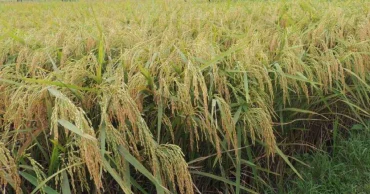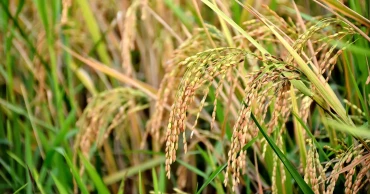paddy
Bumper Aman paddy yield brings joy to farmers in Chapainawabganj
Farmers in Chapainawabganj are celebrating a bumper yield of Aman paddy this season, coupled with favourable prices, thanks to supportive weather conditions and effective farming practices.
The Department of Agricultural Extension (DAE) had set a target of producing 2 lakh metric tonnes of rice this year, and initial reports indicate that the district is on course to meet or even exceed this goal.
During a visit to various parts of the district, farmers were found busy with paddy harvesting and threshing, with fields bustling with activity. Despite early concerns about insufficient rainfall during the planting season, timely irrigation, adequate rainfall later on, and minimal pest infestations led to an impressive harvest.
Rice import from India through Benapole port resumes after 2 years
Farmers are reaping between 22 and 25 maunds of paddy per bigha, with each maund fetching between Tk 1,200 and Tk 1,300 in the market.
These favourable conditions have provided much-needed relief to farmers, many of whom struggled with high production costs earlier in the season.
Calls for Cost ReductionDespite the promising yield and good prices, farmers have urged the government to address the rising costs of pesticides, irrigation, and fertilisers.
Jahangir, a farmer from Atahar in Sadar Upazila, cultivated Aman on 10 bighas of land and expressed satisfaction with his harvest, expecting 24 maunds per bigha.
Rice prices to come down with new Aman rice in market, hopes Food Adviser
However, he noted that early irrigation and high input costs added to his expenses. “If the price remains stable, we will benefit, but reducing input costs would greatly encourage more farmers to engage in Aman cultivation,” he said.
Similarly, Serajul, a farmer from Nezampur in Nachole Upazila, highlighted the financial strain caused by high labour and input costs. He called for government intervention to reduce these expenses, ensuring sustainable farming practices in the region.
Surpassing targetshis year, Aman paddy cultivation exceeded expectations, with 54,415 hectares of land cultivated against the target of 53,350 hectares.
According to Dr Palash Sarkar, Deputy Director of the DAE, the yield per hectare increased from 3.51 metric tonnes last year to 3.61 metric tonnes this year.
Dr Sarkar attributed the success to the timely distribution of high-yielding seeds, fertilisers, and expert guidance provided through various projects and incentives.
“Currently, 16% of the fields have been harvested, and we anticipate this year’s total production will surpass last year’s figure of 1.89 lakh metric tonnes, reaching nearly 2 lakh metric tonnes,” he said.
Farmers are hopeful that stable prices and reduced input costs in the future will ensure a prosperous Aman paddy season in the years to come.
1 year ago
Bumper yield of Boro paddy satisfies Madaripur farmers
Boro cultivation has brought smiles to the farmers of Madaripur district with a bumper yield this season.
During a recent visit to different parts of the district, this correspondent found that farmers are busy harvesting boro paddy.
Siraj Chokdar, 45, a farmer in Lakshiganj village of Sadar upazila, said, “I have brought several bighas of land under boro cultivation. This year's yield is quite good due to the favorable weather. The current price is also good – Tk 1,100 per maund. But if the price of paddy goes down, the farmer will lose,” he said.
Read more: Bumper yield of Boro paddy brings smiles to Chapainawabganj farmers
Merzon Khalasi, 50, another farmer of the same area, said that due to the increase in the price of seeds, fertilizers, pesticides, irrigation and labour costs the production cost has shot up to Tk 800-900 to produce one maund paddy.
Santosh Chandra, deputy director of District Agriculture Extension Department, said that 33,500 hectares of land have been cultivated in five upazilas of the district this year.
Farmers have already harvested 80 percent of Boro paddy in the area and they are expected to benefit due to the bumper paddy yield and good market price of paddy, he added.
Read more: 70% Boro paddy of haor areas harvested: Agriculture Ministry.
2 years ago
90% paddy harvested in haor areas: Minister
Ninety percent boro paddy have been harvested so far in the flood-prone haor areas in the country, said Agriculture Minister Dr. Muhammad Abdur Razzaque on Sunday.
Thirty three percent boro paddy have been harvested across the country so far which is a good start, he said while speaking at a press briefing held at the secretariat.
Mentioning that boro season is the main season of paddy, Razzaque, said every year, 48-49 lakh hectares of land are brought under boro cultivation but this year, 50 lakh hectares of land have been brought under boro cultivation exceeding the target.
Of the total cultivation, 9.50 lakh hectares of land in haor areas have been brought under boro cultivation with a production target of 38 lakh tonnes of paddy, he said.
Also read: Govt procuring Boro paddy at Tk 26 per kg
Recalling the previous experiences during the harvesting time of boro paddy, the minister said haro areas always see flash flood during boro season. “But this year, 90 percent of paddy have been harvested in haro areas and we have made it possible as we encouraged the farmers to harvest their paddy earlier.”
Besides, boro growers in Sunamganj used 1000 combine harvester and 668 reapers to harvest paddy, which is a great achievement, he said.
“This year, the government has set a target to produce 2.15 crore tonnes rice but we hope that we will be able to produce 2.20-2.25 crore tonnes,” he said.
He also hoped that there will be no crisis of food as the weather seems to be favorable till now.
He also said that the price of paddy is better than the previous year and no complaint has been found yet from the farmers in this regard.
2 years ago
70% Boro paddy of haor areas harvested: Agriculture Ministry
Seventy percent of the Boro paddy in haor areas have been harvested, the Ministry of Agriculture (Bangladesh) has said.
In Sylhet, 55 percent paddy was harvested, in Moulvibazar 70 percent was harvested, in Habiganj 67 percent, in Sunamganj 73 percent, in Kishoreganj 58 percent, in Netrokona 77 percent, and in Brahmanbaria 67 percent of Boro paddy was harvested, according to a press release of the ministry today.
Boro paddies were sown on 452,000 hectare of land in haor areas of seven districts this year.And a total of 953,000 hectares of Boro paddy has been cultivated in the highland outside of the haors. The production target is 40 lakh tonnes of rice, said the release.
Read More: Record Boro production to be achieved this year: Agriculture Minister
Recently, Bangladesh's Agriculture Minster Abdur Razzaque launched the Boro paddy harvest in haor areas of Sunamganj ahead of Eid-ul-Fitr. At the time, he said if there was no natural disaster and rice can be brought home on time, there will be record production in Boro this year.
He said only in Sunamganj, around 1,000 combined paddy harvesters are working, adding that there will be no problem in harvesting paddy this time.
According to the Department of Agricultural Extension, Boro has been sown on 50 lakh hectares of land across the country this year, while the production target is 21.5 million metric tonnes of rice.
Read More: Govt to procure 16.50 lakh tonnes Boro paddy, rice
In the last fiscal year 2021-22, Boro rice was sown on 48,14,000 hectares of land, and about 20.2 million tonnes of rice were produced in Bangladesh, the release said.
2 years ago
Govt to procure 16.50 lakh tonnes Boro paddy, rice
The government has set a target to procure 4 lakh tonnes of paddy, 12.50 lakh tonnes of boiled rice and one lakh tonne wheat in the upcoming Boro season.
The procurement of Boro paddy and rice will start from May 7 and continue till August 31, 2023.
The procurement price of Boro paddy has been fixed at Tk 30 per kg, boiled rice at Tk 44 and wheat at Tk 35 per kg. In 2022, the price of paddy was Tk 27 per kg, boiled rice Tk 40 and wheat Tk 28.
The price was fixed at a meeting of the Food Planning and Monitoring Committee (FPMC) at the cabinet meeting room on Thursday. Food Minister Sadhan Chandra Majumder presided over the meeting, according to a press release of the food ministry.
Agriculture Minister Dr Abdur Razzaque, Local Government, Rural Development and Cooperatives Minister Md Tajul Islam, Health and Family Welfare Minister Zahid Maleque, Commerce Minister Tipu Munshi and Fisheries and Livestock Minister SM Rezaul Karim attended the meeting.
Secretaries to different ministries, including the cabinet secretary, were present in the meeting.
2 years ago
14 Top Rice Varieties in Bangladesh
The production of cereal crops in Bangladesh has increased, especially the production of rice. Paddy production was 109 lakh metric tons in 1971, which increased to 564.15 lakh metric tons in 2021 (as per the UN report). Currently, Bangladesh is third in the world in rice production. A total of 8500 varieties of rice are preserved in germplasm in Bangladesh.
Bangladesh Rice Research Institute (BRRI) invented 107 varieties of rice, Bangladesh Atomic Agriculture Research Institute released 25 varieties of rice, and Bangladesh Agricultural University released three varieties of rice. Apart from this, some universities and research institutes in Bangladesh have developed several new varieties of rice.
However, there is some traditional naturally grown rice in Bangladesh. This article will cover the popular and currently available rice in Bangladesh.
Read More: 15 Top Rice Varieties in the World
14 Most Popular Rice Varieties in Bangladesh
Rice has long been considered a symbol of the national prosperity of this country. Food security in Bangladesh basically refers to the safety of paddy or rice. And the following rice has satisfactory production in Bangladesh.
Aman Rice
Among the rice varieties of Bangladesh, Amon ranks at the top regardless of region and production volume. It is also known as winter rice, as this paddy is planted from December to January.
Most of the Aman rice grown in the lowlands of Bangladesh is of the floating variety, locally known as Jali Dhan or Agrahayani Dhan. All are highly photoperiod-sensitive. It is cultivated almost everywhere in Bangladesh. There are about 2,000 cultivars in Bangladesh and more than 6,000 across Asia.
Balam Rice
Greater Barisal was once famous for its traditional thin Balam rice. Since ancient times, Balam rice has been cultivated in the southern region in the fertile in the Ropa Aman season. However, this rice is almost extinct now.
Read More: Govt to import 100,000 MT of rice from India and Singapore
At present, instead of Balam rice, the farmers are cultivating another rice called Shahi Balam of BR-16 variety on a small land. Recently Aman Balam has been available in different shops, which is similar to Balam.
BRRI Rice
The high-yielding and hybrid l rice developed by the Bangladesh Rice Research Institute (BRRI) is called BRRI rice. Initially, they were called BR rice. Now BRRI has hundreds of rice categories, and a few of them are popular. For example, in Amon season, BRRI Dhan 87, which is known as Ropa Amon, has huge popularity.
From this paddy, white long and thin-grain rice is obtained. In addition, the drought-tolerant Aman (BRRI 71), whose rice is long and thick, white in color; The high-yielding Ropa Amon (BRRI 75), whose rice is medium coarse and white in color, and the tidal salt tolerant Ropa Amon (BRRI 76) are also popular. These rice are grown in almost all parts of Bangladesh.
Chinigura Rice
BR 34 variety of rice has been developed by BRRI. The rice obtained from this paddy is called Chinigura Rice, which is the commercial name of this rice. It is grown in the northern part of Bangladesh, such as Naogaon.
Read More: Rice, wheat import: Bangladesh Bank asks banks to keep minimum LC margin
However, the quality of the invented rice is very similar to that of the original traditional Chinigura rice. Chinigura is quite small in size and used in biryani and sometimes in dessert items.
Digha Rice
Mainly grown in Harirampur and Manikganj, Digha Dhan is water friendly, meaning that it does not get damaged by waterlogging or excessive rain. It has wide varieties, but Boga Digha and Hijal Dhiga as popular in the flood-prone areas of Bangladesh. Boga Digha rice grows with rain water and flood water. There is no other cost to cultivate Boga Digha rice except the cost of rice seed and land cultivation.
Hori Rice
Gives more yield - such a new variety of rice was discovered by Haripad Kapali, a farmer of Jhenaidah Sadar Upazila. Which later came to be known as 'Hari Dhan,' and its cultivation started in different parts of the country. The yield is 800-880 KG per bigha, and the bunch of the paddy is strong and sturdy. However, this rice is thick but tasty.
Read More: Give plastic, get rice and other food items: Bidyanondo’s initiative for a waste-free St Martin’s Island
Kalijira Rice
Kalijira rice is one of the best quality rice produced in Bangladesh. This black-colored rice is very tasty, and it is called small Basmati rice. The method of cooking it is almost the same as basmati rice.
This rice is not sticky. Kalijira rice is a geographically indicated product of Bangladesh. This rice is also used in cooking polao, and it is very fragrant. Kalijira is grown in Sherpur, and sometimes it is also sold as Chinigura.
Tulsi Mala Rice
Tulshimala is a photosensitive Amon variety of aromatic rice. The rice is fluffy and tasty, great for polao, biryani, khichuri, rice, cake, fried rice, and other dishes. The reputation and prosperity of Sherpur's Tulshimala rice date back hundreds of years.
Recently Sherpur district branded it as fragrant rice Tulshimala. Although different types of aromatic rice are produced in different districts of the country, Sherpur's Tulshimala rice is different in quality and aroma.
Read More: Food Minister for increasing zinc-enriched paddy cultivation
Katari Bhog Rice
Katari Bhog is a fragrant rice of Bangladesh. It is mainly found in the Dinajpur area. Katari Bhog of Dinajpur is a geographically indicated product of Bangladesh. This rice looks slim and tall. Its tip is slightly pointed and curved like a knife.
This kind of rice is not grown in all areas of Bangladesh. Even in Dinajpur, only Fasilahat, Chhota Baul, Bara Baul, Karimulapur, Khanpur, Chirirbandar Upazila of Dinajpur Sadar Upazila, Kaugaon, Bishtapur, Talpukur Mukundpur, Durgadanga, Viyail, Paschim Baul and Kaharol upazilas cultivate this rice.
Bina Rice
It is a high-yielding, light insensitive, and short duration (138-148 days) Boro rice variety with premium quality, which looks extra tall and slim. The leaves of this variety are erect, narrow, and medium, dark green in color.
Even after the paddy matures, the leaves remain dark green and straight. This type of paddy tree is tall but strong and does not fall. It is grown in highland areas such as in the northern parts of Bangladesh.
Read More: Govt to procure 3 lakh mts Aman paddy at Tk 28 per kg: Food Minister
Miniket Rice
Although there is no rice cultivated in the country called miniket, the Bangladeshi market is flourished with miniket. It is mainly a marketing name. Usually, BRRI 28 and BRRI 29 are marketed mostly under the Miniket name. In the northern part of the country, most of the rice called Miniket is produced from a type of rice called Jirashail.
Besides, this rice is also being produced from rice called BRRI Dhan52, Suballata, and Jira. According to some people, two parboiled rice of any type of thin/narrow paddy is converted into miniket rice.
Najir Shail Rice
The rice we buy in the market, called Najir Shail, is not real Najir Shail rice. The cultivation of this rice is very low, so its rice is not available in the market. But, BRRI 29 rice is further trimmed and polished to give the name 'Nazir Shail.' It is also made from Katari and Jira rice.
Payjam Rice
Payjam rice is generally cultivated more during the Rupa Aman season. This rice is often produced more or less in all districts. Payjam rice looks short and slim in size. It is produced from Aman rice. It has several physical benefits, such as controlling diabetes, being rich in antioxidants, increasing digestion capability, and more.
Read More; Workshop disseminates enormous benefits of zinc paddy
Kaun Rice
Kaun rice was the food of the poor. However, the price of the small grain crop is now beyond the reach of the poor. Kaun is now luxury rice. These grains do not contain sugars like other rice or wheat. Nutritionists recommend Kaun rice as a superfood.
Health-conscious people choose this rice very easily. Kaun rice was used to be cultivated in every village. It is usually cultivated in the northern and southern regions of the country. However, currently, it is cultivated in almost all the districts of North Bengal.
Final Words
Bangladesh is home to a wide variety of rice varieties. Each variety has its own unique characteristics and is used for different purposes. From the aromatic Katari Bhog to the high-yielding BRRI varieties, Bangladesh has a wide range of rice varieties to meet the needs of its people. The country has a long history of rice cultivation and is constantly striving to produce more varieties to meet the needs of its people.
2 years ago
Food Minister for increasing zinc-enriched paddy cultivation
Food Minister Sadhan Chandra Majumder on Tuesday urged the farmers to increase the cultivation of zinc-enriched paddy for eliminating malnutrition in the country.
It is possible to meet the zinc deficiency of people in the country through cultivating biofortified zinc rice, the minister said at the "Biofortified Zinc Rice Award Ceremony 2022" arranged by the Food Ministry in the capital’s Agargaon.
Read more: Boost food production to avert any crisis: PM Hasina
Most of the people in the country are not aware at all about the biofortified zinc rice or its quality, he said.
“We are consuming zinc in chemical form but do not know that we can get this naturally through rice,” he added.
So he urged the media to come forward to attract consumers to biofortified zinc rice.
He also said that the mill owners of the country produce polished rice as per the demand of the consumers and supply those to market. “Because consumers are not keen to eat zinc rice as it is a bit coarse. Customers or consumers prefer polished rice.”
Read more: 27 lakh farmers to get Tk 170 crore as incentives to boost Boro production
And so farmers are also not interested in cultivating biofortified zinc rice, said the minister.
“Normal rice also contains nutrients, but the nutrients are being reduced after being polished,” he added.
He said about 16 lakh tonnes of rice are wasted annually during the polishing process. “There would have been no need to import rice if those had not been polished.”
At the event, 11 farmers, three rice millers and 10 food department officials were awarded in recognition to their special contribution in the production, processing and marketing of biofortified zinc rice.
Meanwhile, regarding food crisis and possible famine, the minister urged all not to panic and said, “We are aware that there are sufficient paddy and rice in stock.”
Strict action will be taken against those who will stockpile rice, Sadhan Chandra warned.
3 years ago
Bumper T-Aman production likely in Khulna this season
Farmers are expecting bumper production of Transplanted Aman (T-Aman) paddy in the district as the cultivation has exceeded the target during the current season.
Officials of the Department of Agricultural Extension (DAE) said farmers are expecting to produce 93,170 MT of T-Aman paddy from 93,185 hectares of cultivated lands in nine upazilas.
The district is likely to see a rise in paddy production compared to the last year, said DAE officials.
READ: Go to village, help boost farm production: PM to Jubo League members
“There is a possibility that this year's T- Aman harvest in Khulna will exceed the target. If the weather remains favorable we will get the expected yield,” said Khulna Deputy Director of DAE Md Hafizur Rahman.
Rupsha Upazila Agriculture Officer Fariduzzaman said, this year the cultivation target has been achieved.
He said deputy assistant agricultural officers are regularly working alongside the farmers at the field level to protect the harvest from insects and pest attack.
“Farmers are being advised to use light traps to prevent attack of Brown Plant Hopper (BPH) locally known as ‘Current Poka.' Yard meetings are also being held with farmers,” he said.
Upazila Agricultural Officers of Batiaghata, Terokhada, Dakope and Dighalia upazilas also agreed on the possibility of bumper yield in their respective upazilas.
READ: Drought hampering Aman production in Bagerhat
Terokhada upazila agricultural officer Shafiqul Islam said farmers have used new variety of seeds this year and no major disease broke out due to regular care.
Arindam Mallik, a farmer of Shobna village in Dumuria upazila, said that the planting of saplings was delayed this year.
“As winter is approaching, nothing much can be said at the moment until the harvesting begins. If there are no natural calamities and insect attacks, then a good yield will be achieved,” he said.
3 years ago
Food controller in Habiganj didn't buy paddy from farmers
The Anti Corruption Commission today conducted an operation against the Upazila Food Controller of Nabiganj upazila under Habiganj, for collecting paddy from a syndicate bypassing the local farmers.
A team consisting of three members from the co-ordinaated office of the ACC in Habiganj conducted the enforcement operation, according to deputy director of ACC Public Relations office Muhammad Arif Sadeq.
The Commission received some allegations that the Food Controller of Nabiganj collected paddy from a selected person and charged extra for allotting dealerships under the Open Market Sale (OMS) scheme.
Read more: ACC won’t renew Shakib’s contract as goodwill ambassador over ‘controversy’
During the operation, the list of farmers selected by the concerned office for the procurement of Boro paddy during the 2021-22 fiscal, receipts of purchase of paddy from farmers, weight standard and inventory certificates, loading/unloading instructions, and Khamar card were retrieved.
Later, the enforcement team visited food warehouses and OMS outlets to verify the authenticity.
The enforcement team will soon submit a report in this regard to the ACC high command, for a review of actions taken and submission of complaint, if necessary, for further action.
3 years ago
Kishoreganj haor farmers not getting fair price for paddy
The paddy farmers of haor upazilas Austagram, Itna, Mithamoin, and Nikli of Kishoreganj district are not getting a fair price of paddy in Chamraghat, Bhairab, and Ashuganj wholesale markets in this Boro paddy harvesting season.
As a result, paddy farmers have been counting Tk 150-250 loss per maund of paddy which will push them into financial trouble.
Haor farmers have already faced two flash floods triggered by incessant downpours and onrush of water from upstream areas in India’s eastern zone. Farmers in the haor areas continue to harvest half-ripe paddy fearing more flash floods instructed by the administration, local lawmakers, and the Department of Agricultural Extension to cut further loss.
As farmers are harvesting half-ripe paddy, they are unable to utilize it fully. This is a huge loss for them. Moreover, the Boro labour crisis has increased the losses as farmers are counting on extra money to get the necessary number of labourers to harvest Boro crops.
This time, the unfair price of paddy has turned the haor farmers unhappy. They are now lamenting and passing days thinking about how they will repay their loans from local lenders.
READ: 90% of haor paddy harvested: Deputy Minister
Boro farmers of haor areas have expressed their resentment about the unfair paddy price. Their disappointment comes when farmers go to the wholesale market to sell BRRI dhan 28 (a Boro paddy variety which ripens early).
Visiting the Chamraghat rice market, the UNB correspondent found farmers from haor areas bringing paddy here by river routes. Rice mill owners buy paddy directly from farmers at this spot.
Farmers said they have been counting huge losses as they are not getting a fair price this year. Mill owners are buying maximum paddy at a low price produced in the haor areas.
The production cost per maund of coarse paddy, including the labour cost, is near Tk 900 while its selling price is only Tk 650 to Tk 750, while plain paddy is being sold at Tk 750 to Tk 850 against the production cost near Tk 1000.
Karim Mia, a farmer of Dhanpur of Itna upazila, said he has expended more than Tk 1,000 to grow one maund paddy. But he is not getting a fair price in the local market which has forced him to sell paddies at lower prices counting huge losses.
Farmer Amin Mia, who has come to sell paddy in Bhairab Bazar wholesale market from Austagram upazila, said most of the farmers in Austagram cultivated Boro croplands by taking lease from the land owners. Many of them have also borrowed money from local creditors. As farmers are not getting a fair price for paddy this year, it will be a tough task for them to maintain their livelihood after paying debts.
He also urged the government to procure paddy at a fair price directly from the farmers.
Ujjal Saha, agriculture officer of Itna upazila said, “Most of the farmers of the haor areas are ultra-poor. They are bound to sell paddy in early Baishakh to pay the borrowed money. Money-lenders put huge pressure on them in Baishakh. If they sell paddies a few days later, they will get a good price.”
3 years ago


















